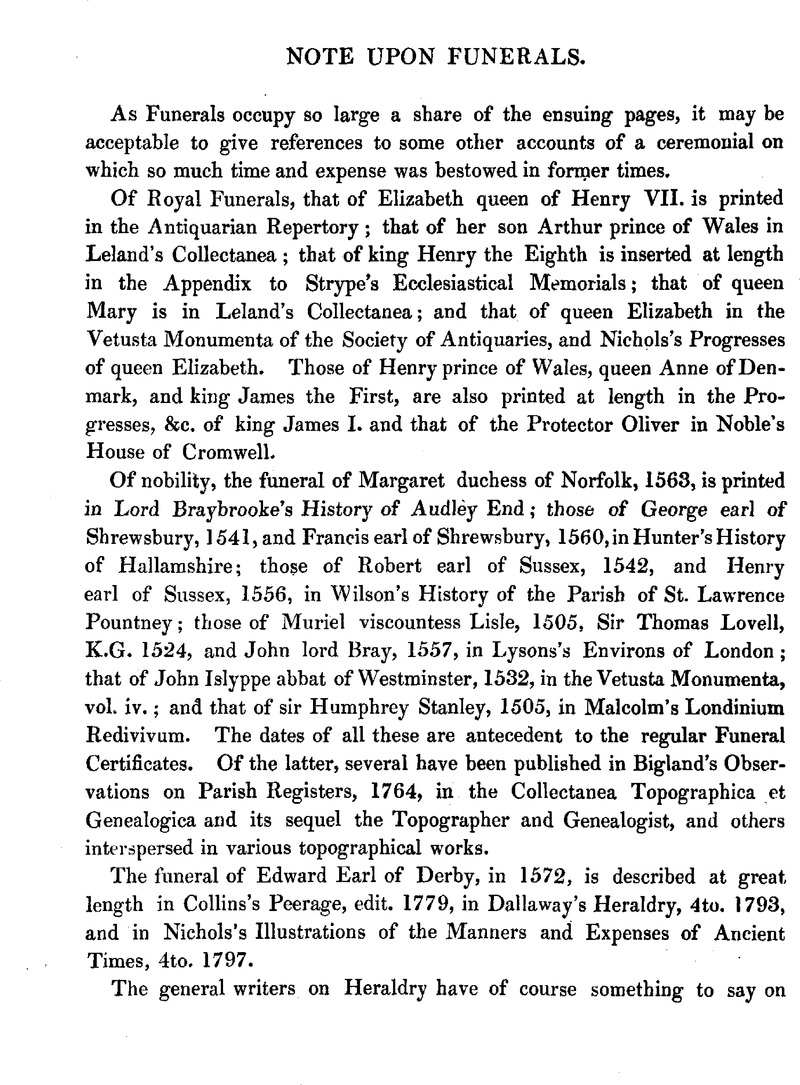Article contents
Note upon Funerals
Published online by Cambridge University Press: 23 February 2010
Abstract

- Type
- Other
- Information
- Camden Old Series , Volume 42: The Diary of Henry Machyn, Citizen and Merchant-Taylor of London, From A.D. 1550 to A.D. 1563. , December 1848 , pp. xx - xxxii
- Copyright
- Copyright © Royal Historical Society 1848
References
page xxi note * The “proceeding” (or order of procession) at the funerals of an Earl, a Countess, a Baron, a Baroness, a Knight, and a Citizen, follow the ceremonial of the Earl of Derby's funeral in the “Illustrations,” &c. mentioned in the preceding page.
page xxii note * MS. Harl. 1354, p. 37b. In MS. Harl. 2129, p. 40, is “The order of the Obseque of sir William Garratt knight, late lord maior of London,” who died temp. James I. which agrees in most particulars with this formulary.
page xxiv note * Thus, in p. 218, “divers aldermen had black, and the residue in violet.” See also pp. 112, 307.
page xxvi note * See Excerpta Historica, 1831, p, 50; where, in line 22, for “two yards” read ten.
page xxvii note * A docquet of a guydon allowed to Hugh Vaughan esquire in 1491 is recorded in the College of Arms. Exoerpta Historica, ubi sup.
page xxvii note † See pp. 18, 19. The word “costerells” in p. 13 remains unexplained.
page xxvii note ‡ In p. 307 Maehyn himself has committed the inadvertence of mentioning the “banner of arms” of master Cholmley the recorder; but from the church notes of the herald Nicholas Charles, we are assured it was only a penon, as he saw in Saint Dunstan's church all the three penons which were carried at this funeral; one of the city of London, one of the Mercers' company, and the third of his own arms. See the Collectanea Topographica et Genealogica, vol. iv. p. 102.
page xxviii note * In the civic shows, particularly on the river, there was always abundance of banners and of streamers (pp. 38, &c.) In the Clerks' procession in 1555 there were a hundred streamers borne (p. 88). They were the peculiar flags of shipping.
page xxix note * The plan of the timber-work of a Herse is given in the Funeral Ceremonials in Nichols's Illustrations, &c. before cited; and Malcolm has engraved one of them with the mourners kneeling around it in his Londinium Redivivum, i. 414.
page xxx note * Described in the Gentleman's Magazine, vol. LXXXIII. i. 82.
page xxx note † Herbert's History of the Twelve City Companies, i. 211.
page xxx note ‡ Ibid. p. 444.
page xxxi note * See the interesting account of its recent examination by the Rev. C. H. Hartshorne.
page xxxi note † It was a practice (and which was kept up until recent times) for ambassadors to leave scocheons at the houses where they slept. An instance occurs in p. 248 of the earl of Bedford, who was going ambassador to France, being provided with “three dozen of lodging scocheons” for this purpose.
- 2
- Cited by




